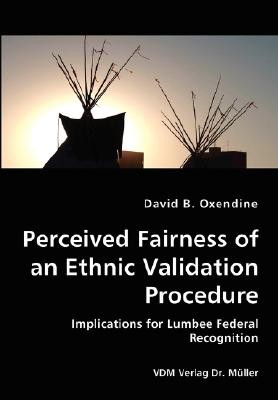
- We will send in 10–14 business days.
- Author: David B Oxendine
- Publisher: VDM Verlag Dr. Mueller E.K.
- Year: 2007
- Pages: 192
- ISBN-10: 3836426315
- ISBN-13: 9783836426312
- Format: 17 x 24.4 x 1 cm, softcover
- Language: English
- SAVE -10% with code: EXTRA
Perceived Fairness of an Ethnic Validation Procedure (e-book) (used book) | bookbook.eu
Reviews
Description
Procedures are used today in all areas of life including business, education, politics and as in this study to determine a group's ethnicity. American Indians are the only ethnic group that must petition to the United States government to validate legally their ethnicity. The purpose of the current study was to explore the effects of social exclusion threat negative affect on the evaluated fairness of a procedure that functions to validate ethnic membership using the Dimensional Voice Model (Bane, 1994). Participants consisted of 120 (60 = female, 60 = male) college students. The study design was a 2 (Gender) X 2 (Justification) X 3 (Procedure) factorial between-groups experimental design. Based on social exclusion theory, individuals may experience high levels of negative affect when they perceive a threat of exclusion from a group (Baumeister & Tice, 1990). It was hypothesized that a procedure designed to validate ethnic mem-bership will result in social exclusion threat negative affect. A procedure designed to validate ethnic membership was hypothesized as being evaluated as un-fair (Thibaut, Walker, LaTour, & Houlden, 1974; Lind & Tyler, 1988; Tyler, 1990, 1994; Tyler & Lind, 1994; Walker, LaTour, Lind, & Thibaut, 1974). Justifications (Bies, 1987a, 1987b, 1989; Bies & Moag, 1986; Bies & Shapiro, 1987, 1988; Brotheridge, 2003; Skarlicki, Folger & Gee, 2004) before the procedure was tested as the rationale for the procedure introduced as procedural justification. Of two procedural justi-fi-ca-tions, the Department of Homeland Security (DHS) and the National Science Foun-da-tion (NSF), the National Science Foundation (NSF) justification was hypothesized as being per-ceived fairer. The results suggest that procedures designed to validate ethnic mem-bership were evaluated as unfair. Additionally, the results indicated that pro-ce-dural justifications might affect perceptions of fairness of the procedure. The data strongly supports the notion that these procedures may create an environment of ne-gative af-fect with respondents evaluating the procedures as unfair. Implications for Lumbee Federal Recognition are discussed.
EXTRA 10 % discount with code: EXTRA
The promotion ends in 20d.20:22:38
The discount code is valid when purchasing from 10 €. Discounts do not stack.
- Author: David B Oxendine
- Publisher: VDM Verlag Dr. Mueller E.K.
- Year: 2007
- Pages: 192
- ISBN-10: 3836426315
- ISBN-13: 9783836426312
- Format: 17 x 24.4 x 1 cm, softcover
- Language: English English
Procedures are used today in all areas of life including business, education, politics and as in this study to determine a group's ethnicity. American Indians are the only ethnic group that must petition to the United States government to validate legally their ethnicity. The purpose of the current study was to explore the effects of social exclusion threat negative affect on the evaluated fairness of a procedure that functions to validate ethnic membership using the Dimensional Voice Model (Bane, 1994). Participants consisted of 120 (60 = female, 60 = male) college students. The study design was a 2 (Gender) X 2 (Justification) X 3 (Procedure) factorial between-groups experimental design. Based on social exclusion theory, individuals may experience high levels of negative affect when they perceive a threat of exclusion from a group (Baumeister & Tice, 1990). It was hypothesized that a procedure designed to validate ethnic mem-bership will result in social exclusion threat negative affect. A procedure designed to validate ethnic membership was hypothesized as being evaluated as un-fair (Thibaut, Walker, LaTour, & Houlden, 1974; Lind & Tyler, 1988; Tyler, 1990, 1994; Tyler & Lind, 1994; Walker, LaTour, Lind, & Thibaut, 1974). Justifications (Bies, 1987a, 1987b, 1989; Bies & Moag, 1986; Bies & Shapiro, 1987, 1988; Brotheridge, 2003; Skarlicki, Folger & Gee, 2004) before the procedure was tested as the rationale for the procedure introduced as procedural justification. Of two procedural justi-fi-ca-tions, the Department of Homeland Security (DHS) and the National Science Foun-da-tion (NSF), the National Science Foundation (NSF) justification was hypothesized as being per-ceived fairer. The results suggest that procedures designed to validate ethnic mem-bership were evaluated as unfair. Additionally, the results indicated that pro-ce-dural justifications might affect perceptions of fairness of the procedure. The data strongly supports the notion that these procedures may create an environment of ne-gative af-fect with respondents evaluating the procedures as unfair. Implications for Lumbee Federal Recognition are discussed.


Reviews